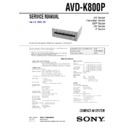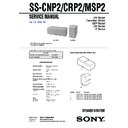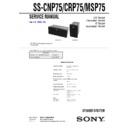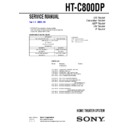Sony AVD-K800P / HT-C800DP Service Manual ▷ View online
2
AVD-K800P
LEAKAGE
The AC leakage from any exposed metal part to earth Ground and
from all exposed metal parts to any exposed metal part having a
return to chassis, must not exceed 0.5 mA (500 microampers).
Leakage current can be measured by any one of three methods.
1.
from all exposed metal parts to any exposed metal part having a
return to chassis, must not exceed 0.5 mA (500 microampers).
Leakage current can be measured by any one of three methods.
1.
A commercial leakage tester, such as the Simpson 229 or RCA
WT-540A. Follow the manufacturers’ instructions to use these
instruments.
WT-540A. Follow the manufacturers’ instructions to use these
instruments.
2.
A battery-operated AC milliammeter. The Data Precision 245
digital multimeter is suitable for this job.
digital multimeter is suitable for this job.
3.
Measuring the voltage drop across a resistor by means of a
VOM or battery-operated AC voltmeter. The “limit” indication
is 0.75 V, so analog meters must have an accurate low-voltage
scale. The Simpson 250 and Sanwa SH-63Trd are examples of
a passive VOM that is suitable. Nearly all battery operated
digital multimeters that have a 2V AC range are suitable. (See
Fig. A)
VOM or battery-operated AC voltmeter. The “limit” indication
is 0.75 V, so analog meters must have an accurate low-voltage
scale. The Simpson 250 and Sanwa SH-63Trd are examples of
a passive VOM that is suitable. Nearly all battery operated
digital multimeters that have a 2V AC range are suitable. (See
Fig. A)
Fig. A. Using an AC voltmeter to check AC leakage.
0.15
µ
F
To Exposed Metal
Parts on Set
Parts on Set
1.5k
Ω
AC
voltmeter
(0.75V)
voltmeter
(0.75V)
Earth Ground
CAUTION
Use of controls or adjustments or performance of procedures
other than those specified herein may result in hazardous
radiation exposure.
other than those specified herein may result in hazardous
radiation exposure.
Notes on chip component replacement
• Never reuse a disconnected chip component.
• Notice that the minus side of a tantalum capacitor may be
• Notice that the minus side of a tantalum capacitor may be
damaged by heat.
Flexible Circuit Board Repairing
• Keep the temperature of soldering iron around 270˚C
during repairing.
• Do not touch the soldering iron on the same conductor of the
circuit board (within 3 times).
• Be careful not to apply force on the conductor when soldering
or unsoldering.
SAFETY CHECK-OUT
After correcting the original service problem, perform the following
safety checks before releasing the set to the customer:
Check the antenna terminals, metal trim, “metallized” knobs, screws,
and all other exposed metal parts for AC leakage. Check leakage as
described below.
safety checks before releasing the set to the customer:
Check the antenna terminals, metal trim, “metallized” knobs, screws,
and all other exposed metal parts for AC leakage. Check leakage as
described below.
Laser component in this product is capable of emitting radiation
exceeding the limit for Class 1.
exceeding the limit for Class 1.
This appliance is classified as a
CLASS 1 LASER product.
The CLASS 1 LASER
PRODUCT MARKING is
located on the rear exterior.
CLASS 1 LASER product.
The CLASS 1 LASER
PRODUCT MARKING is
located on the rear exterior.
SAFETY-RELATED COMPONENT WARNING!!
COMPONENTS IDENTIFIED BY MARK
0
OR DOTTED LINE WITH
MARK
0
ON THE SCHEMATIC DIAGRAMS AND IN THE PARTS
LIST ARE CRITICAL TO SAFE OPERATION. REPLACE THESE
COMPONENTS WITH SONY PARTS WHOSE PART NUMBERS
APPEAR AS SHOWN IN THIS MANUAL OR IN SUPPLEMENTS
PUBLISHED BY SONY.
COMPONENTS WITH SONY PARTS WHOSE PART NUMBERS
APPEAR AS SHOWN IN THIS MANUAL OR IN SUPPLEMENTS
PUBLISHED BY SONY.
Unleaded solder
Boards requiring use of unleaded solder are printed with the lead-
free mark (LF) indicating the solder contains no lead.
(Caution: Some printed circuit boards may not come printed with
the lead free mark due to their particular size.)
free mark (LF) indicating the solder contains no lead.
(Caution: Some printed circuit boards may not come printed with
the lead free mark due to their particular size.)
: LEAD FREE MARK
Unleaded solder has the following characteristics.
• Unleaded solder melts at a temperature about 40
• Unleaded solder melts at a temperature about 40
°C higher than
ordinary solder.
Ordinary soldering irons can be used but the iron tip has to be
applied to the solder joint for a slightly longer time.
Soldering irons using a temperature regulator should be set to
about 350
Ordinary soldering irons can be used but the iron tip has to be
applied to the solder joint for a slightly longer time.
Soldering irons using a temperature regulator should be set to
about 350
°C.
Caution: The printed pattern (copper foil) may peel away if the
heated tip is applied for too long, so be careful!
heated tip is applied for too long, so be careful!
• Strong viscosity
Unleaded solder is more viscous (sticky, less prone to flow) than
ordinary solder so use caution not to let solder bridges occur such
as on IC pins, etc.
ordinary solder so use caution not to let solder bridges occur such
as on IC pins, etc.
• Usable with ordinary solder
It is best to use only unleaded solder but unleaded solder may
also be added to ordinary solder.
also be added to ordinary solder.
ATTENTION AU COMPOSANT AYANT RAPPORT
À LA SÉCURITÉ!
LES COMPOSANTS IDENTIFÉS PAR UNE MARQUE
0
SUR LES
DIAGRAMMES SCHÉMATIQUES ET LA LISTE DES PIÈCES SONT
CRITIQUES POUR LA SÉCURITÉ DE FONCTIONNEMENT. NE
REMPLACER CES COMPOSANTS QUE PAR DES PIÈSES SONY
DONT LES NUMÉROS SONT DONNÉS DANS CE MANUEL OU
DANS LES SUPPÉMENTS PUBLIÉS PAR SONY.
CRITIQUES POUR LA SÉCURITÉ DE FONCTIONNEMENT. NE
REMPLACER CES COMPOSANTS QUE PAR DES PIÈSES SONY
DONT LES NUMÉROS SONT DONNÉS DANS CE MANUEL OU
DANS LES SUPPÉMENTS PUBLIÉS PAR SONY.
The following caution
label is located inside
the apparatus.
label is located inside
the apparatus.
3
AVD-K800P
NOTES ON HANDLING THE OPTICAL PICK-UP BLOCK
OR BASE UNIT
OR BASE UNIT
The laser diode in the optical pick-up block may suffer electrostatic
break-down because of the potential difference generated by the
charged electrostatic load, etc. on clothing and the human body.
During repair, pay attention to electrostatic break-down and also
use the procedure in the printed matter which is included in the
repair parts.
The flexible board is easily damaged and should be handled with
care.
break-down because of the potential difference generated by the
charged electrostatic load, etc. on clothing and the human body.
During repair, pay attention to electrostatic break-down and also
use the procedure in the printed matter which is included in the
repair parts.
The flexible board is easily damaged and should be handled with
care.
NOTES ON LASER DIODE EMISSION CHECK
The laser beam on this model is concentrated so as to be focused on
the disc reflective surface by the objective lens in the optical pick-
up block. Therefore, when checking the laser diode emission,
observe from more than 30 cm away from the objective lens.
the disc reflective surface by the objective lens in the optical pick-
up block. Therefore, when checking the laser diode emission,
observe from more than 30 cm away from the objective lens.
LASER DIODE AND FOCUS SEARCH OPERATION
CHECK
CHECK
Carry out the “S curve check” in “CD section adjustment” and check
that the S curve waveform is output several times.
that the S curve waveform is output several times.
MODEL IDENTIFICATION
— BACK PANEL —
Part No.
• Abbreviation
E51 : Chilean and peruvian models.
Model
US and E51 models
Canadian model
Mexican model
AEP model
UK model
PARTS No.
4-244-942-0
s
4-244-942-1
s
4-244-942-2
s
4-244-942-3
s
4-244-942-4
s
HOW TO OPEN THE DISC TRY WHEN POWER SWITCH TURNS OFF
3
loading (panel)
2
table
1
Turn the gear (shaft) in the
direction of the arrow.
gear (shaft)
hole of chassis
4
AVD-K800P
1. GENERAL
·········································································· 5
2. DISASSEMBLY
2-1. Case ··············································································· 7
2-2. Loading (PANEL) ························································· 8
2-3. CD Mechanism Deck (CDM79-DVBU22) ··················· 8
2-4. Front Panel Assy ···························································· 9
2-5. DISPLAY Board, OPEN/CLOSE Board,
2-2. Loading (PANEL) ························································· 8
2-3. CD Mechanism Deck (CDM79-DVBU22) ··················· 8
2-4. Front Panel Assy ···························································· 9
2-5. DISPLAY Board, OPEN/CLOSE Board,
POWER SWITCH Board, HP Board ···························· 9
2-6. Tuner Unit (TM301), I/O Board ·································· 10
2-7. DMB03 Board ····························································· 10
2-8. DC Fan (FAN1) ··························································· 11
2-9. MAIN Board ······························································· 11
2-10. Table Assy ··································································· 12
2-11. SE-130 Board ······························································ 13
2-12. DC Motor (M001) ······················································· 14
2-13. Pickup Unit Section ····················································· 14
2-14. RF Board ····································································· 15
2-7. DMB03 Board ····························································· 10
2-8. DC Fan (FAN1) ··························································· 11
2-9. MAIN Board ······························································· 11
2-10. Table Assy ··································································· 12
2-11. SE-130 Board ······························································ 13
2-12. DC Motor (M001) ······················································· 14
2-13. Pickup Unit Section ····················································· 14
2-14. RF Board ····································································· 15
3. TEST MODE
··································································· 16
4. DIAGRAMS
4-1. Circuit Board Location ················································ 25
4-2. Block Diagrams
4-2. Block Diagrams
— RF SERVO Section — ··········································· 26
— VIDEO Section — ·················································· 27
— AUDIO Section — ················································· 28
— AMP Section — ····················································· 29
— POWER Section — ················································ 30
— VIDEO Section — ·················································· 27
— AUDIO Section — ················································· 28
— AMP Section — ····················································· 29
— POWER Section — ················································ 30
4-3. Printed Wiring Board — RF Section — ······················ 31
4-4. Schematic Diagram — RF Section — ························ 32
4-5. Printed Wiring Board — DMB Section (SIDE A) — · 33
4-6. Printed Wiring Board — DMB Section (SIDE B) — · 34
4-7. Schematic Diagram — DMB Section (1/8) — ··········· 35
4-8. Schematic Diagram — DMB Section (2/8) — ··········· 36
4-9. Schematic Diagram — DMB Section (3/8) — ··········· 37
4-10. Schematic Diagram — DMB Section (4/8) — ··········· 38
4-11. Schematic Diagram — DMB Section (5/8) — ··········· 39
4-12. Schematic Diagram — DMB Section (6/8) — ··········· 40
4-13. Schematic Diagram — DMB Section (7/8) — ··········· 41
4-14. Schematic Diagram — DMB Section (8/8) — ··········· 42
4-15. Printed Wiring Board — I/O Section — ····················· 43
4-16. Schematic Diagram — I/O Section — ························ 44
4-17. Printed Wiring Board — MAIN Section — ················ 45
4-18. Schematic Diagram — MAIN Section (1/3) — ·········· 46
4-19. Schematic Diagram — MAIN Section (2/3) — ·········· 47
4-20. Schematic Diagram — MAIN Section (3/3) — ·········· 48
4-21. Printed Wiring Board
4-4. Schematic Diagram — RF Section — ························ 32
4-5. Printed Wiring Board — DMB Section (SIDE A) — · 33
4-6. Printed Wiring Board — DMB Section (SIDE B) — · 34
4-7. Schematic Diagram — DMB Section (1/8) — ··········· 35
4-8. Schematic Diagram — DMB Section (2/8) — ··········· 36
4-9. Schematic Diagram — DMB Section (3/8) — ··········· 37
4-10. Schematic Diagram — DMB Section (4/8) — ··········· 38
4-11. Schematic Diagram — DMB Section (5/8) — ··········· 39
4-12. Schematic Diagram — DMB Section (6/8) — ··········· 40
4-13. Schematic Diagram — DMB Section (7/8) — ··········· 41
4-14. Schematic Diagram — DMB Section (8/8) — ··········· 42
4-15. Printed Wiring Board — I/O Section — ····················· 43
4-16. Schematic Diagram — I/O Section — ························ 44
4-17. Printed Wiring Board — MAIN Section — ················ 45
4-18. Schematic Diagram — MAIN Section (1/3) — ·········· 46
4-19. Schematic Diagram — MAIN Section (2/3) — ·········· 47
4-20. Schematic Diagram — MAIN Section (3/3) — ·········· 48
4-21. Printed Wiring Board
— VOLTAGE SELECTOR, LOADING Section — ··· 49
4-22. Schematic Diagram — LOADING Section — ··········· 50
4-23. Printed Wiring Board — DISPLAY Section — ·········· 51
4-24. Schematic Diagram — DISPLAY Section — ············· 52
4-25. IC Block Diagrams ····················································· 54
4-26. IC Pin Function Description ······································· 61
4-23. Printed Wiring Board — DISPLAY Section — ·········· 51
4-24. Schematic Diagram — DISPLAY Section — ············· 52
4-25. IC Block Diagrams ····················································· 54
4-26. IC Pin Function Description ······································· 61
5. EXPLODED VIEWS
5-1. Case Section ································································ 70
5-2. Front Panel Section ····················································· 71
5-3. Chassis Section ···························································· 72
5-4. CD Mechanism Deck Section-1 (CDM79-DVBU22) · 73
5-5. CD Mechanism Deck Section-2 (CDM79-DVBU22) · 74
5-2. Front Panel Section ····················································· 71
5-3. Chassis Section ···························································· 72
5-4. CD Mechanism Deck Section-1 (CDM79-DVBU22) · 73
5-5. CD Mechanism Deck Section-2 (CDM79-DVBU22) · 74
6. ELECTRICAL PARTS LIST
······································· 75
Ver 1.1
TABLE OF CONTENTS
NOTES ON DMB03 BOARD EXCHANGE
If a DMB03 board is exchanged, “DRIVE AUTO ADJUSTMENT”
may be unable to be performed. In this case, initialize a memory in
the following procedure.
may be unable to be performed. In this case, initialize a memory in
the following procedure.
1. Starting Test Mode (see page 17).
2. Press the 2 button of remote commander to set the Drive
2. Press the 2 button of remote commander to set the Drive
Manual Operation (see page 19).
3. Press the 6 button of remote commander to set the Memory
Check (see page 21).
4. Press the [CLEAR] button of remote commander to initialize
a memory.
AUTO SERVO ADJUSTMENT
After parts related to the servo circuit (RF amplifier (IC001), DSP
(IC509), motor driver (IC501), EEPROM (IC903) so on) are
replaced, re-adjusting the servo circuit is necessary. Select “ALL”
at “1. DRIVE AUTO ADJUSTMENT” (Refer to page 18 in TEST
MODE) and adjust DVD-SL (single layer), CD and DVD-DL (dual
layer).
(IC509), motor driver (IC501), EEPROM (IC903) so on) are
replaced, re-adjusting the servo circuit is necessary. Select “ALL”
at “1. DRIVE AUTO ADJUSTMENT” (Refer to page 18 in TEST
MODE) and adjust DVD-SL (single layer), CD and DVD-DL (dual
layer).
RFMON Level Check
Perform a RFMON level check before exchanging optical pick-up.
Measurement Point: DMB03 board CN501
13pin (RFMON) — 29pin (AGND)
RFMON signal waveform
• Standard value
Test Disc
RFMON level
Standard Value
DVD
TDV-520CSO
1.09
± 0.2Vp-p
(J-2501-236-A)
CD
LUV-P01
1.05
± 0.2Vp-p
(4-999-032-01)
VOLT/DIV: 200 mV
TIME/DIV: 500 ns
TIME/DIV: 500 ns
RFMON level
5
AVD-K800P
SECTION 1
GENERAL
Front Panel
?/1
PHONES
DISC SELECT
MULTI CHANNEL DECODING
1
2
3
4
5
SUB WOOFER
LEVEL
FUNCTION
PRESET
+
–
+
MASTER
VOLUME
VOLUME
SOUND FIELD
EX-CHANGE DISC SKIP
OPEN/CLOSE
–
+
1
?/1 (power switch) (29)
2
(remote sensor) (18)
3 MULTI CHANNEL DECODING
indicator (49)
4 Front panel display (12)
5 Disc tray (29)
6 EX-CHANGE (30)
7 DISC SKIP (29)
8
5 Disc tray (29)
6 EX-CHANGE (30)
7 DISC SKIP (29)
8
A OPEN/CLOSE (29)
9 SOUND FIELD +/– (50)
0 MASTER VOLUME control (29, 70)
qa SUB WOOFER LEVEL (69)
qs FUNCTION (29)
qd PRESET +/–, ./> (27, 30)
qf
0 MASTER VOLUME control (29, 70)
qa SUB WOOFER LEVEL (69)
qs FUNCTION (29)
qd PRESET +/–, ./> (27, 30)
qf
x (stop) (30)
qg
S (pause) (30)
qh
H (play) (29)
qj DISC SELECT 1 – 5 (29)
qk PHONES jack (29)
qk PHONES jack (29)
Rear Panel
L
R
y
AM
AUDIO IN
VIDEO IN
FRONT R
SURR R SUB WOOFER SURR L
– +
– +
– +
+
–
+
–
+
–
FRONT L
CENTER
SPEAKERS
VOLTAGE
SELECTOR
Y
TV
ANTENNA
120V
220V
L
R
AUDIO IN
VIDEO
MONITOR
COMPONENT
VIDEO OUT
VIDEO OUT
P
R
/C
R
P
B
/C
B
1 AM antenna terminals (22)
2 FM 75
2 FM 75
Ω COAXIAL antenna jack (22)
3 VOLTAGE SELECTOR (only for
equipped models) (25)
4 Ventilation holes (fan) (74)
5 SPEAKERS jacks (20)
5 SPEAKERS jacks (20)
6 COMPONENT VIDEO OUT jacks (24)
7 MONITOR (VIDEO OUT) jack (24)
8 VIDEO (AUDIO L/R IN/VIDEO IN)
7 MONITOR (VIDEO OUT) jack (24)
8 VIDEO (AUDIO L/R IN/VIDEO IN)
jacks (24)
9 TV (AUDIO L/R IN) jacks (24)
This section is extracted
from instruction manual.
from instruction manual.





